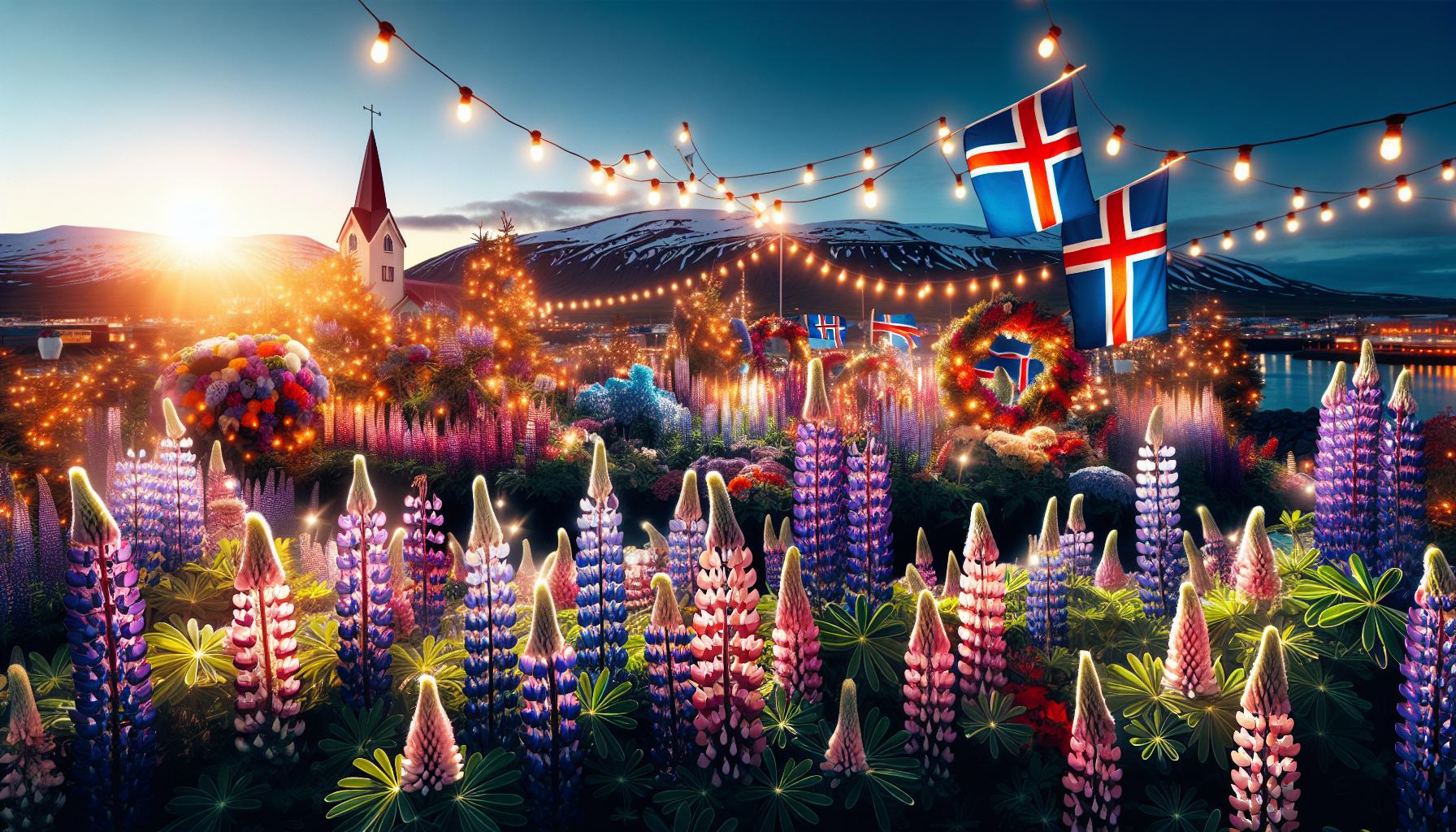The vibrant lupine flower, now a striking symbol of Icelandic landscapes, has an intriguing history rooted in its journey from North America to Europe. Understanding this botanical migration not only highlights the ecological impact of introduced species but also enriches our appreciation of the stunning purple fields that transform Iceland’s scenery each summer.
The Arrival of Lupine: A Journey Across the Seas
The story of how lupines came to Iceland is a fascinating tale of beauty and ecological impact, painting a vivid picture of the island’s botanical evolution. Originally hailing from regions like North America, specifically the western coast, the Nootka lupine (*Lupinus nootkatensis*) was introduced to European shores in the late 18th century. This perennial plant thrives in various climates and has become well-established in Iceland, reshaping the landscape with its striking blue-purple flowers. Today, approximately 0.5 percent of Iceland’s land is adorned with these vibrant blooms, making them an unforgettable aspect of the island’s natural scenery [1].
From Sea to Land: The Introduction of Lupines
The arrival of lupines in Iceland can be traced back to deliberate attempts at land reclamation and soil stabilization during the early 20th century. As Iceland faced significant soil erosion and degradation, botanists and agriculturalists recognized the potential of the lupine to restore the fragile ecosystems. The plant’s nitrogen-fixing ability greatly enriched the soil, promoting the growth of other flora and revitalizing barren landscapes. This transformative mechanism became crucial in combating desertification in the countryside, particularly in areas devastated by grazing and volcanic activity.
Impact and Adaptation
Since their introduction, lupines have flourished across Iceland, especially in regions like Mývatn, where the geothermal environment and picturesque lakes provide a perfect backdrop for their growth. Over the years, these flowers have not only become emblematic of Iceland’s unique ecological landscapes but have also sparked diverse opinions regarding their impact on native species. Critics argue that the invasive nature of the lupine can overshadow indigenous plants, while supporters celebrate their role in habitat restoration.
In understanding how the presence of lupine has evolved in Iceland, it is essential to consider the balance between fostering biodiversity and utilizing introduced species for ecological benefits. Local communities often engage in discussions about managing lupine growth to ensure that while they continue to enjoy the beauty and advantages this plant offers, the integrity of Iceland’s native ecosystems remains preserved. Thus, the journey of lupine across the seas represents not only an environmental success story but also a complex challenge in biodiversity management.
Overall, the arrival and establishment of lupines in Iceland serve as a powerful reminder of how human intervention can alter landscapes— for better or worse— and the ongoing responsibility we carry to nurture the delicate balance within these ecosystems.
From the Wilds of North America to the Heart of Iceland
The journey of the lupine flower from its native habitat in North America to the stunning landscapes of Iceland is a captivating tale that highlights both botanical resilience and ecological adaptation. Originally, the lupinus nootkatensis, or Nootka lupine, flourished along the western coast of North America, where it thrived in nutrient-rich soils and cooler climates. This perennial plant was introduced to Europe in the late 18th century and found a unique and unexpected home in Iceland during the 20th century.
Lupines were brought to the island not merely for their aesthetic appeal but primarily for their ability to restore nitrogen to depleted soils, making them valuable in combating erosion and promoting the health of the barren landscapes. Their introduction was part of a broader effort to reclaim land that had been adversely affected by centuries of farming and overgrazing. As they spread across the terrain, lush fields of vibrant purple blooms began to transform the once-dry expanses into a visual feast, attracting nature lovers and photographers alike.
Transformation and Adaptation
The adaptation of lupines to Iceland’s unique climate is remarkable. Despite facing harsh conditions, these hardy plants not only survived but thrived, flourishing in the cool summers and westerly winds characteristic of Iceland. Their extensive root systems enable them to access deep soil layers, allowing them to withstand periods of drought while also preventing soil erosion. The success of lupines in Iceland serves as an excellent example of how introduced species can become integral to their new ecosystems when appropriately managed.
- Pollinator Support: The flowers attract various pollinators, including bees, which further enhance local biodiversity.
- Soil Improvement: The nitrogen-fixing capabilities of lupines enrich the soil, benefitting subsequent crops or native flora.
- Tourism and Photography: The vivid stretches of lupines have become a significant draw for tourists, offering picturesque landscapes to capture and enjoy.
The spread of lupine flowers across Iceland is a testament to their ecological importance and the role they play in landscape restoration. Their vibrant colors not only beautify the rugged terrain but also contribute significantly to the island’s floral diversity. This botanical history reveals the journey of a beloved plant that has become synonymous with the enchanting landscapes of Iceland, making it a vital part of the country’s environmental narrative.
Understanding the Role of Lupine in Icelandic Ecosystems
The presence of lupines in Iceland showcases a fascinating example of how a single plant species can significantly transform an ecosystem. Introduced primarily for soil stabilization and to combat erosion, lupine has rapidly spread across the landscape, becoming a striking feature of the Icelandic flora. This plant not only adds vibrant colors to the monotonous volcanic terrains but also plays a crucial role in enhancing soil fertility, a factor that is critical in an environment where soil quality is often compromised.
Nitrogen Fixation and Soil Enrichment
One of the primary benefits of lupine lies in its ability to fix atmospheric nitrogen. This process makes nitrogen available in a form that is readily accessible to other plants, thereby promoting biodiversity. The nitrogen-fixing bacteria associated with lupine roots enhance the overall fertility of the soil, facilitating the growth of a wider variety of plant species. As lupine thrives, it prepares the groundwork for subsequent plant communities, transitioning barren landscapes into lush ecosystems.
Biodiversity Support
In addition to supporting soil health, lupine serves as a pioneer species that aids in the establishment of more complex ecological communities. By providing shelter and food for various insects and wildlife, lupine becomes a catalyst for the growth of diverse plant life. Some advantages include:
- Habitat Creation: Lupine plants create habitats for pollinators and other small animals, fostering greater species diversity.
- Resource Availability: The increased nitrogen in the soil makes it possible for other plants, particularly native species, to thrive, enriching the ecosystem further.
The integration of lupine into the Icelandic ecosystem demonstrates the importance of understanding plant interactions and the ecological roles species play after being introduced. This knowledge, highlighted in discussions around the themes presented in “How Did Lupine Flower Get to Iceland: Botanical History Uncovered,” underscores the need for careful management of introduced species to sustain the ecological balance.
Lupine’s rapid growth and ability to alter landscapes reveal both the challenges and opportunities faced in managing Iceland’s unique ecosystems. For those interested in ecological restoration or studying plant adaptation, examining the role of lupine presents valuable insights into how introduced species impact their new environments.
Local Legends: How Lupine Transformed Icelandic Landscapes
The introduction of the Nootka lupine to Iceland in 1945 marked a pivotal moment in the country’s ecological history. Originally native to North America, this vibrant flower was brought to Iceland as part of an ambitious reforestation and soil reclamation project. The harsh conditions of Iceland, including frequent volcanic eruptions and overgrazing by livestock, had left significant areas of land barren and struggling. As a result, the lupine’s role in transforming these landscapes is considered both remarkable and contentious.
Not only has the elegant lupine flourished across Iceland, covering an estimated 0.5 percent of the land surface, but it has also dramatically altered the aesthetics of the Icelandic scenery. Regions like Mývatn have become famous for their stunning fields of lupines, with the blue flowers creating a striking contrast against the rugged landscape. This transformation has attracted tourists and photographers, eager to capture the beauty of the “lunar landscape” infused with vibrant purple hues. As these plants populate the land, they contribute to soil stabilization, erosion control, and the gradual restoration of native habitats.
However, the introduction of lupines has not been without controversy. While they serve essential ecological functions, there are concerns about their impact on native flora and fauna. The lupine’s ability to dominate the landscape can overshadow native species, leading to a reduction in biodiversity. Thus, the story of the lupine in Iceland is a tale of both beauty and ecological tension, revealing the complexity of introducing non-native species in delicate environments.
For those visiting Iceland, witnessing the lupine’s vast fields not only offers a visual treat but also invites deep reflection on the ongoing balance between nature and human intervention. Whether exploring the scenic fjords or hiking through the expansive fields of lupines, travelers are encouraged to appreciate the intricate role this flower plays in Iceland’s evolving story. As you roam the captivating landscapes, consider how non-native introductions, like the lupine, continue to shape not just the land but also the cultural narratives threaded throughout Iceland’s rich history.
The Cultural Significance of Lupine in Iceland
The introduction of lupine flowers to Iceland is not just a tale of botanical interest; it has intertwined deeply with the cultural fabric of the country. Initially brought over for soil stabilization and agricultural purposes, these vibrant purple blooms have since captured the hearts and imaginations of Icelanders and visitors alike. This transformation from a utilitarian plant to a beloved emblem of Iceland’s natural beauty underscores the unique relationship between the Icelandic people and their landscape.
Historical Context
Originally introduced in the late 1940s, lupines were seen as an essential tool for combating soil erosion, which has plagued many parts of Iceland due to its harsh climate and volcanic landscape. As the plants took root, their striking colors began to dominate the surroundings, particularly in areas like the Mývatn region. Today, they are celebrated not only for their ecological contributions but also for their aesthetic value, altering the way nature is perceived in the ever-changing Icelandic environment. The lupine fields have become a symbol of resilience and adaptability, reflecting the Icelandic spirit itself.
Modern Cultural Significance
In contemporary Iceland, lupines have solidified their role in various cultural expressions. They are featured in artwork, photography, and literature, symbolizing beauty, transience, and the stark juxtaposition of nature and human intervention. Festivals and community events often highlight the blooming season, drawing crowds eager to witness the stunning vistas. These events serve as a reminder of how culturally significant the lupine has become, transforming from a mere plant into a cherished aspect of Icelandic identity.
- Photography: The vibrant lupine fields provide stunning backdrops for both amateur and professional photographers, helping to promote Iceland as a prime destination for nature lovers.
- Art: Local artists often draw inspiration from the lupines, incorporating their vivid colors and forms into paintings and crafts.
- Tourism: Tour operators now include lupine fields in their itineraries, capitalizing on the flowers’ popularity to enhance the travel experience for visitors.
Even the environmental debate surrounding the lupine’s introduction has cultural implications, spawning discussions about nature conservation and the balance between human intervention and ecological integrity. These conversations reflect a broader awareness and evolving perspectives on sustainability in the face of climate change, resonating strongly within Iceland’s international image.
Through the lens of cultural significance, the histoire of the lupine in Iceland is more than a botanical narrative; it illustrates a vibrant dialogue between nature and humanity, emphasizing the intricate balance that forms the foundation of Icelandic culture.
Gardening Tips: Cultivating Lupine in Your Icelandic Garden
Lupines are not just visually stunning with their tall, colorful spikes; they play a vital role in the ecosystem, especially in a rugged environment like Iceland’s. These resilient plants, which are thought to have arrived in Iceland in the 19th century, have become a beloved feature of the Icelandic landscape. As you consider adding lupines to your garden, understanding their unique needs and how to cultivate them can significantly enhance your gardening experience.
Choosing the Right Location
To thrive, lupines prefer full sun and well-drained soil. When selecting a spot in your Icelandic garden, look for areas that receive at least six hours of sunlight daily. Soil should be rich in nutrients but not overly moist, as lupines are susceptible to root rot in waterlogged conditions.
Planting Techniques
Planting lupines is straightforward, whether from seeds or cuttings. If you are using seeds, consider these steps for optimal germination:
- Scarification: Gently scratch the seed surface or soak the seeds overnight in lukewarm water. This helps break down the tough outer coat.
- Chilling: For added success, you can chill the seeds in the refrigerator for a week before planting.
Once prepared, sow the seeds in late spring or early summer when the soil temperature reaches about 15°C (60°F). Space seeds about 30 cm (12 inches) apart, allowing room for their robust growth.
Maintenance and Care
After planting, proper care will ensure your lupines flourish. Regular maintenance includes:
- Watering: Water the plants during dry spells, particularly in the early stages of growth.
- Mulching: Apply a layer of mulch to retain moisture and suppress weeds.
- Fertilization: Because lupines fix nitrogen in the soil, additional fertilization is often unnecessary, but a balanced fertilizer can enhance blooming in nutrient-poor soils.
Incorporating these practices into your gardening routine will help replicate the conditions under which lupines thrive in their native habitat, as discussed in “How Did Lupine Flower Get to Iceland: Botanical History Uncovered.” By appreciating both their beauty and ecological benefits, you’ll contribute positively to your landscape while enjoying the vibrant blooms they offer.
The Controversy: Invasive Species or Beneficial Ally?
The introduction of the lupine flower to Iceland sparked a heated debate among environmentalists, botanists, and the general public. Originally seen as a tool for combating soil erosion and enriching poor soils, the lupine quickly transformed from a welcomed resource into a controversial species. This nuanced discussion revolves around the question of whether the lupine serves as an invasive species or a beneficial ally in Iceland’s unique ecosystem, especially in light of its botanical history.
Understanding Invasive Nature
Lupins, particularly the *Lupinus nootkatensis*, were brought to Iceland in the early 20th century with aspirations of restoring degraded landscapes. While these vibrant flowers thrived, their rapid spread raised concerns regarding native plant life. Invasive species are often characterized by their ability to reproduce quickly and dominate new environments, as noted by the Smithsonian National Museum of Natural History. This is precisely the case with the lupine, as it can outcompete many indigenous plants for resources, which can lead to a decline in local biodiversity.
The Argument for Beneficial Ally
Despite its invasive tendencies, advocates argue that the lupine provides several ecological benefits. They highlight how the plant’s ability to fix nitrogen in the soil improves soil quality, which can facilitate the growth of other plant species over time. In the barren, volcanic landscapes of Iceland, this capability has been crucial in promoting recovery after periods of environmental degradation. For instance, lupines create a more hospitable environment for seedlings of native species, fostering a gradual restoration process.
- Soil Enrichment: The nitrogen fixation contributes to soil fertility, which is a step towards ecosystem recovery.
- Erosion Control: Their root systems help anchor the soil, reducing erosion in vulnerable areas.
- Adaptive Planting: Encouraging a mixed planting strategy that includes native species alongside lupines may enhance overall biodiversity.
In conclusion, the lupine flower’s presence in Iceland illustrates the duality present in discussions of invasive species. While it poses challenges to native flora, its role as an ecosystem modifier cannot be disregarded. The ongoing dialogue surrounding this plant urges us to consider management strategies that incorporate both ecological benefits and the need to protect native biodiversity, exemplifying the complex nature of our relationship with introduced species as explored in *How Did Lupine Flower Get to Iceland: Botanical History Uncovered*. By fostering awareness and implementing thoughtful strategies, we can navigate this controversy effectively and create more resilient ecosystems for the future.
Exploring Iceland’s Flora: The Bigger Picture of Botanical Diversity
The arrival of the lupine flower in Iceland is not just a botanical curiosity; it serves as a fascinating lens through which to appreciate the broader spectrum of Iceland’s flora. The journey of the lupine reflects how external influences can shape local ecosystems, leading to a vibrant tapestry of plant life that is both resilient and adaptive. This journey underscores the interplay between species, their environment, and human intervention, creating a dynamic landscape that thrives despite the island’s challenging conditions.
In Iceland, the flora is diverse yet specialized due to the unique climatic conditions and volcanic soil. Among the approximately 540 plant species that inhabit the island, the hardy lupine stands out. Originally introduced to combat soil erosion and improve land use, these plants have now flourished across the landscape, showcasing the ability of certain species to adapt and even thrive outside their native habitats. The story of lupine’s introduction provides a perfect example of how certain non-native species can contribute to ecological balance while also sparking discussions about biodiversity and conservation.
The Unique Ecosystem of Iceland
Understanding the larger picture of Iceland’s botanical diversity requires an appreciation of its ecological framework. The island’s native vegetation consists primarily of low-growing species such as willows, bilberries, and heathers, which tolerate harsh winds and poor soil fertility. However, the adaptation of introduced species like lupine has led to changes in the local ecosystem, affecting both flora and fauna. The robust root systems of lupines help to stabilize the soil and provide nitrogen, enriching the earth for other plants.
- Native Wildlife Interaction: Species such as the Arctic fox and various bird populations rely on the native vegetation for sustenance and habitat.
- Adaptive Strategies: Many Icelandic plants exhibit unique adaptations; for instance, the ability to withstand extreme cold and nutrient-poor rocky soils.
- Future Conservation Efforts: The growing diversity, including both native and non-native species, highlights the need for sustainable management practices to preserve Iceland’s ecosystems.
As one delves deeper into the topic of ‘How Did Lupine Flower Get to Iceland: Botanical History Uncovered’, it becomes evident that the study of these interactions not only enriches our understanding of Icelandic flora but also exemplifies broader ecological principles that can be applied globally. Emphasizing the importance of preserving both native and introduced species is vital for maintaining ecological health, making Iceland a living laboratory for ecological research and conservation. Understanding these dynamics will be crucial as we navigate the complexities of climate change and biodiversity loss in the years to come.
FAQ
How did the lupine flower get to Iceland?
The lupine flower was introduced to Iceland in the 1940s to combat soil erosion, becoming widespread across the landscape since then. It was brought intentionally as a means of ecological restoration.
This beautiful flower, especially the Alaskan lupine, was favored for its ability to thrive in harsh environments. Over time, it transformed the Icelandic landscape, leading to mixed feelings among locals about its dominance over native flora.
Why is the lupine flower important in Iceland?
The lupine flower plays a vital role in improving soil quality and reducing erosion in Iceland. Its nitrogen-fixing properties help to rejuvenate the soil, making it more fertile for other plants.
Despite its benefits, the influx of lupines has led to ecological concerns, as they can outcompete native species. The debate about their impact touches on broader themes of conservation and biodiversity in Iceland.
What are the effects of the lupine invasion in Iceland?
The lupine invasion has significantly altered Iceland’s natural landscape, often overshadowing native plants. While it aids soil stabilization, it raises concerns about biodiversity loss.
Many Icelanders have mixed feelings—some appreciate the beauty of the vibrant purple fields, while others worry about the ecological consequences. This ongoing debate highlights the importance of balancing beauty with sustainability.
Can I see lupine flowers in Iceland year-round?
No, lupine flowers in Iceland bloom primarily in the summer months, from June through early August. This vibrant display attracts many visitors eager to witness the stunning purple fields.
Planning your trip during this peak season ensures you experience the full bloom. Many tourists enjoy scenic drives or hikes through these colorful landscapes, turning each visit into a memorable adventure.
What other plants are found alongside lupines in Iceland?
While lupines are prominent, Iceland is home to various other plants, including birch, mosses, and heather. These species contribute to the unique ecological tapestry of the region.
Many local guides offer tours that showcase not only lupines but also the rich diversity of Icelandic flora, providing deeper insight into the delicate balance of this ecosystem.
Why do some people dislike the lupine flower in Iceland?
Some people dislike the lupine flower due to its invasive nature, which threatens local biodiversity. Concerns arise about its dominance over native plants, potentially disrupting ecosystems.
This tension reflects broader issues regarding introduced species and conservation efforts. Balancing the appreciation of its beauty with ecological integrity is an ongoing discussion among locals and botanists alike.
How does the lupine flower influence tourism in Iceland?
The stunning purple fields of lupine flowers significantly influence tourism in Iceland. Many travelers specifically visit to capture the beauty of these blooms, contributing to the country’s allure.
Tourists often share their experiences on social media, further promoting Iceland as a destination. This phenomenon highlights the interplay between nature and tourism, demonstrating how one can drive interest in the other.
Insights and Conclusions
As we wrap up our exploration of the lupine flower’s botanical journey to Iceland, it’s clear that this vibrant bloom is more than just a pretty sight—it’s a symbol of adaptation and change in the Icelandic landscape. From its controversial introduction to its role in soil stabilization, the lupine’s presence has become intertwined with local culture and nature.
Picture yourself wandering through fields of mesmerizing purple, where each blossom tells a story of resilience and beauty amidst Iceland’s rugged terrain. Local tales reveal how villagers delight in the sight of these flowers during the short summer months, a reminder of nature’s ability to thrive against the odds. Engaging with this fascinating piece of Icelandic history not only enriches your travel experience but also nurtures a deeper appreciation for the delicate balance between nature and human influence.
So, whether you’re an avid photographer looking to capture the stunning vistas or a nature enthusiast unraveling the mysteries of this unique ecosystem, make sure to seek out the lupine fields on your next Icelandic adventure. Embrace the journey, explore local stories, and let the allure of the lupine inspire you—there’s a world waiting to be discovered, and the lupine flower is just the beginning. Don’t hesitate to dive deeper into Iceland’s botanical wonders and share your experiences, for every story adds to the rich tapestry of this enchanting land. Happy exploring!






